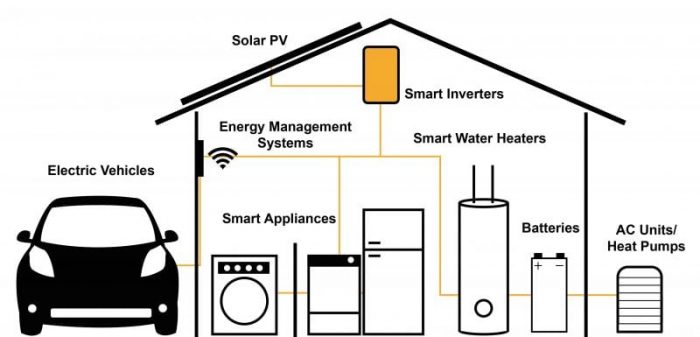
Grid-tied residential solar photovoltaic (PV) systems reduce customer grid electricity costs. In most major PV markets, customers are also compensated for PV output exported to the grid. Grid export compensation rates are falling around the world, meaning that customers face incentives to increase self-use and reduce grid exports. However, the ability of customers to self-use PV output is limited by the instantaneous nature of electricity generation: PV output generated by the midday sun is no longer available for self-use later in the day and evening.
Researchers at the U.S. National Renewable Energy Laboratory (NREL) are exploring ways to increase the value of PV through integration with devices that increase self-use. PV-paired batteries can be charged with the midday sun then discharged later in the day, allowing customers to self-use PV output long after the sun has set. In addition to batteries, load control devices allow customers to synchronize home appliances with PV output. For instance, smart thermostats can be configured to pre-cool the home during the day with PV output, increasing self-use by delivering excess PV output to the home’s air conditioner rather than to the grid. Then, when the sun has set, the pre-cooled home reduces the home’s reliance on grid electricity for further cooling. A plethora of home appliances are suitable for load control, as well as electric vehicles (see Figure). The researchers refer to this PV optimization strategy as “solar plus.”

The solar plus home (Credit: Eric O’Shaughnessy)
In a recent study published in Applied Energy, the authors demonstrate the economic value of solar plus for customers in different rate structures. Through a series of case studies and sensitivity analyses, the authors show that solar plus can increase PV value by as much as a factor of eight, depending on customer rate structures. The researchers show that solar plus can increase PV value in rate structures with any of three characteristics.
First, solar plus increases PV value when electricity rates are higher than grid export compensation rates. In these cases, excess output can be delivered to solar plus devices such as batteries and load control devices rather than exported to the grid. This approach increases the value of excess output, given that the customer saves more money from reducing grid electricity use than would be earned through grid export compensation. In a case study based on a home in Las Vegas, NV, U.S.A., the authors find that solar plus can increase PV value by about 10% when the electricity rate is $0.10/kWh higher than the grid export compensation rate, and by about 50% when the electricity rate is $0.20/kWh higher than the grid export compensation rate.
Second, solar plus increases PV value for customers that pay different peak and off-peak electricity rates, also known as time-of-use (TOU) rates. For TOU customers, solar plus devices can shift PV output into the peak rate period, reducing the customer’s grid electricity use during the most expensive time of the day. The authors show that this strategy, also known as TOU arbitrage, is especially lucrative when the customer’s peak period occurs later in the day after PV output has subsided. Based on the Las Vegas case study, the authors show that solar plus increases PV value by about a factor of six when the peak period occurs in the late afternoon and evening (5pm-10pm).
Third, solar plus increases PV value for customers that pay a fee proportional to their peak power use during some time period, also known as a demand charge. For residential customers, peak power use generally occurs in the late afternoon when customers return home from daily activities. These demand peaks typically occur after PV output has subsided, so that PV output alone is relatively ineffective at peak reduction. Solar plus devices can extend PV output into the customer’s peak period, reducing the customer’s peak demand and the associated demand charge. The study shows that solar plus can increase PV value by as much as a factor of eight based on a demand charge case study in Arizona, U.S.A.
Future research will examine how large-scale solar plus deployment could affect electricity grids. Policymakers and grid planners may be able to increase the value of PV to the grid by configuring solar plus devices to offer grid services. Some utilities have already implemented pilot projects to test how aggregations of PV and solar plus devices can provide grid services. Due to the customer- and grid-level values of solar plus, falling battery costs, and the increasing availability of load control technologies, the future of PV looks increasingly integrated with batteries and load control technologies.
These findings are described in the article entitled Solar plus: Optimization of distributed solar PV through battery storage and dispatchable load in residential buildings, recently published in the journal Applied Energy. This work was conducted by Eric O’Shaughnessy, Dylan Cutler, Kristen Ardani, and Robert Margolis from the National Renewable Energy Laboratory.









